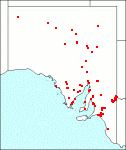Family: Amaranthaceae
Halosarcia indica
Citation:
Paul G. Wilson, Nuytsia 3:63 (1980).
Synonymy: Salicornia indica Willd., Neue Schr. Ges. naturf. Freund. Berl. 2:111 (1799).
Common name: None
Description:
Decumbent perennial to stout erect shrub; articles cylindrical to obovoid, frequently glaucous; margin entire or ciliolate.
Spikes terminal, smooth and cylindrical and up to 4 cm long or ovoid and up to 2 cm long; bract-pairs truncate or deeply lobed, margin entire or ciliolate; flowers coalescent or free, completely enclosed or with the apex exposed, ascending; apex rounded or obtuse; perianth thin or fleshy; lateral lobes large; abaxial lobe within the laterals, minute or equal to them in size.
Fruiting spike leathery, corky or spongy; fruitlets laterally compressed; perianth soft and spongy; pericarp hard and horny all over, adherent to the perianth, eventually splitting in the sagittal plane; seed ovate to circular; testa membranous, very pale-brown; spike disarticulating with age; bracts and perianth frequently swelling when wet.
Published illustration:
Williams (1984) Native plants of Queensland 2:151 .
|
Conservation status:
native
Flowering time: No flowering time is available |

SA Distribution Map based
on current data relating to
specimens held in the
State Herbarium of South Australia
|
Biology:
H. indica differs markedly in its anatomy from all other members of the Salicornieae in having only a single layer of palisade cells within which is a layer of thick-walled chlorenchymatous cells that frequently become lignified.
Taxonomic notes:
A very variable taxon which is considered by some authors to consist of several species. This is partly because, except for Australia, each country contains only one of the variants; in Australia all variants occur and intergrade with each other. The following subspecies represent the more obvious of the numerous variants.
Key to Infraspecific taxa:
|
1. Spike cylindrical or ellipsoid, lowest ring of bracts small; vegetative articles truncate or shallowly lobed |
|
subsp. leiostachya 5b. |
|
1. Spike ovoid, lowest ring of bracts large and deeply lobed; vegetative articles deeply lobed |
|
subsp. bidens 5a. |
Author:
Not yet available
| 
